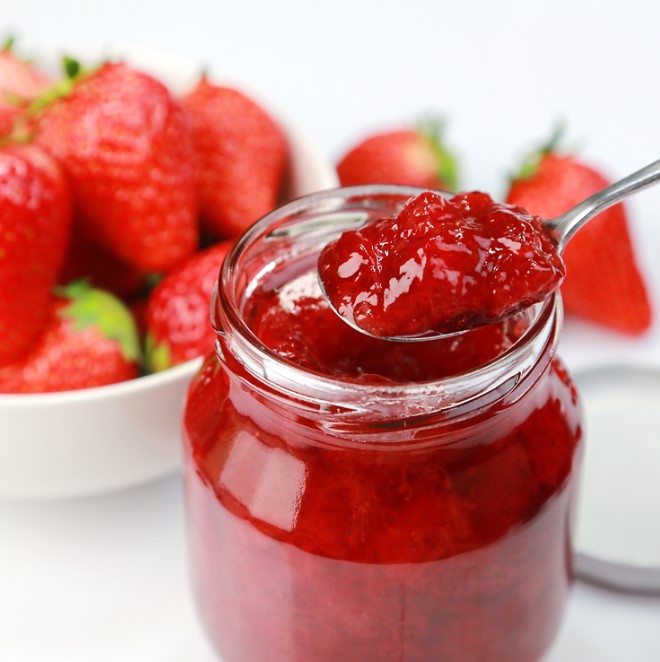What You Need to Know Before Starting
When you decide to make your own strawberry jam recipe, you embrace a delightful endeavor. Not only does homemade strawberry jam taste superior, but you also gain complete control over the ingredients, guaranteeing a healthier product without the excess sugars and preservatives that many store-bought jams contain. Mastering a superb homemade strawberry jam recipe comes from understanding the balance of fruit, sugar, and pectin, which ensures a perfect set and delicious flavor.
Essential Ingredients for Strawberry Jam
The foundation of any great strawberry jam recipe is the quality of the fruit used. Here’s what you’ll need for your strawberry jam recipe:
- Strawberries: Approximately 900 grams of ripe, firm, and flavorful strawberries. They should be washed, hulled, and crushed. Ripe strawberries provide the best natural sweetness and color for your jam recipe.
- Sugar: 800 grams to preserve the jam and enhance its sweet flavor. You can adjust the amount based on your taste and health preferences.
- Lemon Juice: About 2-3 tablespoons, sourced from 1 large lemon. The natural pectin in lemon juice helps set the jam and provides a tangy balance to the sweetness.
- Pectin: A 50-gram package to achieve a consistent set, especially if you’re using less ripe or lower pectin fruits for your strawberry jam recipe.
Equip Yourself with the Right Tools
Here’s what you’ll need for the perfect strawberry jam recipe:
- Large Pot: A wide, heavy-bottomed pot is best for making strawberry jam, allowing for quick evaporation and to prevent burning.
- Wooden Spoon and Spatula: Essential for stirring your strawberry jam recipe, helping prevent the fruit from sticking to the pot.
- Jars and Lids: Sterilized canning jars and new lids will ensure your strawberry jam is stored safely.
- Canning Funnel and Ladle: To transfer the hot strawberry jam to jars efficiently.
The Perfect Strawberry Jam Recipe
Step-by-Step Instructions
- Prepare Your Strawberries: Select fresh strawberries and rinse them under cold water.
- Hull the Strawberries: Remove the green caps with a paring knife or huller.
- Crush for Texture: Use a potato masher or blender to achieve your desired strawberry texture.
- Sugar Mixture: Mix the crushed strawberries and sugar, drawing out the natural juices.
- Cooking Your Strawberry Jam Recipe: Transfer the mixture to a pot and bring it to a boil.
- Adding Lemon Juice and Pectin: Incorporate the lemon juice and pectin into your boiling mixture for your strawberry jam recipe.
- Testing the Jam’s Consistency: Continue to boil and test using the cold plate method for the perfect set.
- Canning the Jam: Sterilize your jars, fill them with jam, and process in a water bath.
Tips for Perfect Consistency and Flavor
- Testing Consistency: Use a candy or digital thermometer to check if the jam has reached the gel point at around 220°F (104°C).
- Enhancing Flavor: Infuse the jam with herbs like basil or mint during cooking, removing them before canning.
- Reducing Foam: A small amount of butter can be added during boiling to reduce foaming.
Health Benefits of Strawberry Jam
Strawberry jam isn’t just delicious; it’s also packed with health benefits, especially when homemade. Strawberries are a great source of vitamin C, manganese, folate, and potassium. They are also rich in antioxidants, which combat free radicals.
Nutritional Content of Strawberries
Strawberries offer more than just vitamin C; they contain significant amounts of antioxidants known as polyphenols, which are beneficial for heart health and blood sugar control.
Health Advantages of Homemade Jams
Making jam at home allows you to significantly reduce added sugars, avoid preservatives, and customize your recipes to maximize nutritional benefits.
Variations of Strawberry Jam Recipes
Incorporating Other Fruits
Experiment with adding different fruits like blackberries, blueberries, or rhubarb to introduce new flavors and textures.
Sugar-Free and Low-Sugar Variants
For those monitoring sugar intake, consider using honey, agave, or artificial sweeteners suitable for cooking.
Preserving and Storing Your Jam
Best Practices for Long-Term Storage
Properly processed and sealed, homemade strawberry jam can last up to two years in a cool, dark place. Once opened, keep refrigerated and use within a month.
Common Mistakes to Avoid in Jam Storage
- Not Sterilizing Jars: Proper sterilization prevents contamination and spoilage.
- Overfilling Jars: This can prevent a proper seal and lead to spoilage.
Using Strawberry Jam in Everyday Cooking
Breakfast Recipes with Strawberry Jam
Transform your morning meals with strawberry jam. Spread it on toast, swirl it into oatmeal, or layer it in a yogurt parfait.
Desserts and Sweets Featuring Strawberry Jam
Strawberry jam is a versatile ingredient in desserts. Use it in turnovers, cheesecakes, or simply drizzle over ice cream for a delicious treat.
The History and Culture of Jam Making
Jam-making is a deeply rooted culinary tradition spanning various cultures and centuries. Initially, it was a method to preserve seasonal fruits for the off-season. Over time, it has evolved into an art form, with each region adding its unique twist to the basic technique.
Historical Significance of Jam
The practice of jam-making dates back to the Crusades, when the method was brought back to Europe from the Middle East.
Jam in Different Cultures
In different parts of the world, jams vary widely. For example, in Eastern Europe, jams are often spiced with cloves and cinnamon, while in Asia, some jams include unique ingredients like ginger or star anise.
Frequently Asked Questions About Making Jam
Solving Common Jam-Making Problems
Issues like crystallization or overly runny jam can often be fixed by adjusting the amount of sugar or pectin.
Can You Make Jam with Frozen Strawberries?
Absolutely, you can make jam using frozen strawberries. In fact, using frozen strawberries can be a convenient option, especially when fresh strawberries are out of season or if you want to utilize bulk berries that were frozen at their peak ripeness. Here’s what you need to know about making strawberry jam with frozen strawberries:
Advantages of Using Frozen Strawberries
- Year-Round Availability: Frozen strawberries allow you to enjoy the flavor of strawberries and make jam any time of the year, regardless of the season.
- Consistent Quality: Since frozen strawberries are typically picked and frozen at their peak ripeness, they often have a consistent quality and taste.
- Convenience: Using frozen strawberries can save preparation time as they are usually already hulled and cleaned before freezing.
Considerations When Using Frozen Strawberries
- Thawing: It’s important to thaw your strawberries completely before starting your jam-making process. This can be done overnight in the refrigerator or more quickly at room temperature. Ensure to retain any juices that release during thawing, as they contain flavors and pectin.
- Extra Liquid: Frozen strawberries might release more liquid compared to fresh strawberries. This additional liquid can affect the consistency of your jam if not managed properly. You might need to cook the jam slightly longer to achieve the desired thickness and texture.
- Sugar Adjustment: Depending on your preference and the sweetness of the strawberries, you may need to adjust the amount of sugar. Frozen strawberries can sometimes be slightly less sweet than their fresh counterparts if they’ve been stored for a long time.
Better With or Without Pectin?
Deciding whether to use pectin in your strawberry jam can influence not only the texture and set of the jam but also its cooking time and shelf life. The choice between adding pectin or going pectin-free depends on your preferences for texture, natural fruit flavor, and the time you want to spend making jam.
With Pectin
Pros:
- Consistent Set: Pectin ensures that the jam sets properly and uniformly, which is particularly helpful for beginners or those who want reliable results every time.
- Shorter Cooking Time: Using pectin reduces the cooking time required to achieve a set, preserving more of the fresh flavor of the strawberries and minimizing the degradation of their natural vibrant color.
- Improved Texture: For those who enjoy a firmer, more gel-like consistency in their jams, pectin can provide that texture without the need to add excessive sugar or cook the fruit for a longer period.
Cons:
- Less Natural Flavor: Because the jam cooks for a shorter period, it might retain more of the natural fruit flavor, but the addition of pectin might dilute or alter the natural strawberry flavors slightly.
- Additional Ingredient: Pectin is an extra ingredient that some might prefer to avoid, especially if aiming for a jam with fewer processed components.
Without Pectin
Pros:
- Deeper Flavor Development: Cooking jam without pectin typically takes longer, allowing for a more concentrated fruit flavor as the mixture reduces. This method can result in a richer, more robust flavor profile.
- Simpler Ingredients: For those preferring a more natural approach or for whom the texture is less of a concern, making jam without pectin means using just the basic ingredients: fruit, sugar, and perhaps lemon juice.
Cons:
- Longer Cooking Time: Without pectin, jam needs to cook longer to reach the gelling point, during which more water evaporates from the fruit. This process requires more attention to prevent burning and may result in a darker color due to caramelization of sugars.
- Variable Texture: Achieving the perfect set can be more challenging without pectin, particularly if the natural pectin levels in the fruit are low or inconsistent. The final product may be too runny or too thick, depending on how long it cooks.
Conclusion
Whether strawberry jam is better with or without pectin really depends on your individual preferences and priorities. If you value ease, consistency, and a brighter fruit flavor, using pectin is beneficial. On the other hand, if you prefer a more artisanal approach and don’t mind spending more time cooking the jam to achieve a potentially richer flavor, making it without pectin could be more satisfying. Each method has its merits, and many jam makers enjoy experimenting with both to find their perfect balance.
Conclusion: The Joy of Jam Making
Homemade strawberry jam not only offers a richer taste and healthier options but also connects us to the traditions of the past. It is a satisfying, creative process that can be enjoyed with family and friends.

